Here is a very nice video about the Creative Commons license. If you watch it and click on the ad at the end you'll be supporting the Commons. For more info and more videos about the Creative Commons, visit this site.
[!] The blog has moved [!]
The blog has moved to http://carlitoscontraptions.com/.
You will be redirected to the new URL in 5 s. Sorry for the inconvenience.
You will be redirected to the new URL in 5 s. Sorry for the inconvenience.
December 12, 2006
December 06, 2006
Quick and Cheap Laptop Lamp
I built this quick laptop lamp some time ago for my mom. It is very simple and requires very few materials.
Materials
Once the body was clean and shiny (it was completely black before) , I removed the lamp power connector and replaced it with the USB plug. In order to achieve this, the red (pin 1) terminal must be connected to the positive lead and the black (pin 4) terminal, to the lamp ground.
The lamp is basically done.
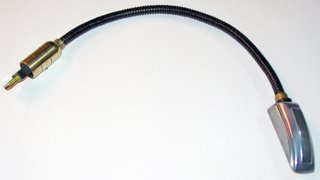 Since I did not have the appropriate light bulb for the lamp I had to adapt a bulb by adding a solder blob on its side. Now it fits perfectly.
Since I did not have the appropriate light bulb for the lamp I had to adapt a bulb by adding a solder blob on its side. Now it fits perfectly.
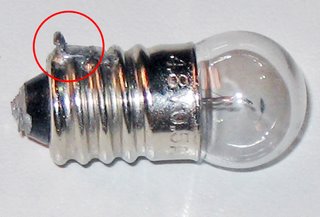
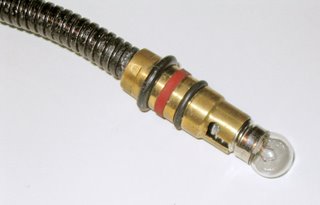 This lamp won't be as power efficient as the LED ones but it is cheap, quick and very simple to build. Enjoy.
This lamp won't be as power efficient as the LED ones but it is cheap, quick and very simple to build. Enjoy.
Materials
- 1 type A male USB plug
- 1 light bulb (that works well at around 5V)
- 1 lamp body (I found mine in the garbage)
Once the body was clean and shiny (it was completely black before) , I removed the lamp power connector and replaced it with the USB plug. In order to achieve this, the red (pin 1) terminal must be connected to the positive lead and the black (pin 4) terminal, to the lamp ground.
The lamp is basically done.
 Since I did not have the appropriate light bulb for the lamp I had to adapt a bulb by adding a solder blob on its side. Now it fits perfectly.
Since I did not have the appropriate light bulb for the lamp I had to adapt a bulb by adding a solder blob on its side. Now it fits perfectly.
 This lamp won't be as power efficient as the LED ones but it is cheap, quick and very simple to build. Enjoy.
This lamp won't be as power efficient as the LED ones but it is cheap, quick and very simple to build. Enjoy.
December 04, 2006
Bogotá Rake
A Bogotá (besides being a city) is a very effective lock picking tool. It is surprisingly easy to build and allows you to open lots of locks very quickly and easily. I have been able to open many locks just minutes after having this little tool done (including standard door and bicycle locks).
For this project you only need one street sweeper bristle. You can find these on the streets after a street sweeper passed by. Their rotating brushes leave behind these precious bristles.
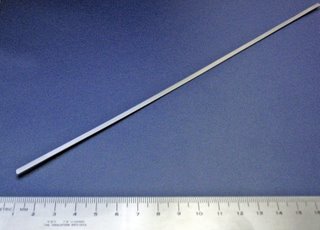
First you need a template. I found this very good one from Exodus5000.
 You have to print it at its original size (@ 500 pixels/inch) onto a piece of paper, cut it using scissors or some other cutting device, and paste the paper using normal glue onto the bristle (after it has been cleaned of course). You should get something like this:
You have to print it at its original size (@ 500 pixels/inch) onto a piece of paper, cut it using scissors or some other cutting device, and paste the paper using normal glue onto the bristle (after it has been cleaned of course). You should get something like this:

Then, using a permanent marker paint around it and remove the paper.
Now, use some files to remove all the painted sections until you get the desired shape.
 Sand it very thoroughly. It is very important. First use a medium grain sandpaper and the a fine one. In order to sand all the curvy sections, I used a piece of sandpaper rolled around a medium nail. In the end, it should be smooth as ....hum... as something very very smooth. This allows for a fluid motion of the Bogotá inside the lock (important if you want to get the lock open).
Sand it very thoroughly. It is very important. First use a medium grain sandpaper and the a fine one. In order to sand all the curvy sections, I used a piece of sandpaper rolled around a medium nail. In the end, it should be smooth as ....hum... as something very very smooth. This allows for a fluid motion of the Bogotá inside the lock (important if you want to get the lock open).
I accidentally broke my bristle. With the broken piece I built a tension wrench. it is a bit short, but it works well. If you want one, just bend the bristle (not to much or you may snap it)
 For those who don't already know, a tension wrench is used to apply a small tension to the lock while you pick it. See this article for more information.
For those who don't already know, a tension wrench is used to apply a small tension to the lock while you pick it. See this article for more information.
With these tools you can now start a life of crime. You should be able to open simple locks (and perhaps more complex ones) in a couple of minutes. Simply apply a small tension to the lock (as if turning it with a key) using the tension wrench, and jiggle the Bogotá inside the lock rapidly and randomly. The lock should open in less than a minute (keep trying if it doesn't).
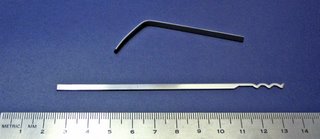
Disclaimer: I do not condone leading a criminal life. However, if my blog does inspire you to become some sort of criminal and you succeed well at it, please share a bit of your earnings with me. After all, you will be doing well thanks to me.
For this project you only need one street sweeper bristle. You can find these on the streets after a street sweeper passed by. Their rotating brushes leave behind these precious bristles.

First you need a template. I found this very good one from Exodus5000.
 You have to print it at its original size (@ 500 pixels/inch) onto a piece of paper, cut it using scissors or some other cutting device, and paste the paper using normal glue onto the bristle (after it has been cleaned of course). You should get something like this:
You have to print it at its original size (@ 500 pixels/inch) onto a piece of paper, cut it using scissors or some other cutting device, and paste the paper using normal glue onto the bristle (after it has been cleaned of course). You should get something like this:
Then, using a permanent marker paint around it and remove the paper.
Now, use some files to remove all the painted sections until you get the desired shape.
 Sand it very thoroughly. It is very important. First use a medium grain sandpaper and the a fine one. In order to sand all the curvy sections, I used a piece of sandpaper rolled around a medium nail. In the end, it should be smooth as ....hum... as something very very smooth. This allows for a fluid motion of the Bogotá inside the lock (important if you want to get the lock open).
Sand it very thoroughly. It is very important. First use a medium grain sandpaper and the a fine one. In order to sand all the curvy sections, I used a piece of sandpaper rolled around a medium nail. In the end, it should be smooth as ....hum... as something very very smooth. This allows for a fluid motion of the Bogotá inside the lock (important if you want to get the lock open).I accidentally broke my bristle. With the broken piece I built a tension wrench. it is a bit short, but it works well. If you want one, just bend the bristle (not to much or you may snap it)
 For those who don't already know, a tension wrench is used to apply a small tension to the lock while you pick it. See this article for more information.
For those who don't already know, a tension wrench is used to apply a small tension to the lock while you pick it. See this article for more information.With these tools you can now start a life of crime. You should be able to open simple locks (and perhaps more complex ones) in a couple of minutes. Simply apply a small tension to the lock (as if turning it with a key) using the tension wrench, and jiggle the Bogotá inside the lock rapidly and randomly. The lock should open in less than a minute (keep trying if it doesn't).

Disclaimer: I do not condone leading a criminal life. However, if my blog does inspire you to become some sort of criminal and you succeed well at it, please share a bit of your earnings with me. After all, you will be doing well thanks to me.
December 03, 2006
Wireless AM receiver
This is the schematics for a wireless AM receiver composed of a tuned amplifier, a AM demodulator, and an audio amplifier.

 This is the radio receiver implemented on a breadboard.
This is the radio receiver implemented on a breadboard.
I'll post more details soon.

 This is the radio receiver implemented on a breadboard.
This is the radio receiver implemented on a breadboard.I'll post more details soon.
Opamp
My teammate and I designed an integrated op amp. The circuit is implemented using Gennum GA911 technology. It is built so we can test many configuration (i.e. using active or passive biasing). Se below the circuit layout and some pictures of the resulting chip in it's natural environment.
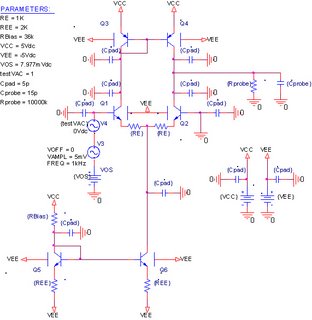 Active-loaded differential amplifier. This is the first Stage of the op amp, with a 5o dB Gain.
Active-loaded differential amplifier. This is the first Stage of the op amp, with a 5o dB Gain.
 Class-AB output stage. This second stage alows for driving small loads and increases the overall gain a bit (~10 V/V).
Class-AB output stage. This second stage alows for driving small loads and increases the overall gain a bit (~10 V/V).
Note: all circuit schematics account for the pin capacitance of the packaged IC (Cpad = 5 pF). Also the loading effect of the oscilloscope probe used to perform the experimental measurements is accounted for in the schematics by modeling the probe as a resistor (Rprobe = 1 MΩ) in parallel with a capacitor (Cprobe = 15 pF).
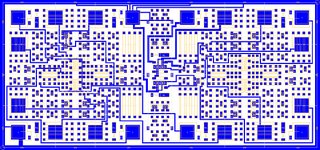 IC layout (done using Electric).
IC layout (done using Electric).
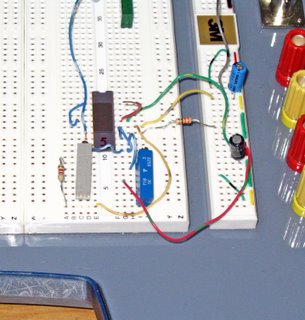 The chip (a.k.a. #5) being tested.
The chip (a.k.a. #5) being tested.
 Active-loaded differential amplifier. This is the first Stage of the op amp, with a 5o dB Gain.
Active-loaded differential amplifier. This is the first Stage of the op amp, with a 5o dB Gain. Class-AB output stage. This second stage alows for driving small loads and increases the overall gain a bit (~10 V/V).
Class-AB output stage. This second stage alows for driving small loads and increases the overall gain a bit (~10 V/V).Note: all circuit schematics account for the pin capacitance of the packaged IC (Cpad = 5 pF). Also the loading effect of the oscilloscope probe used to perform the experimental measurements is accounted for in the schematics by modeling the probe as a resistor (Rprobe = 1 MΩ) in parallel with a capacitor (Cprobe = 15 pF).
 IC layout (done using Electric).
IC layout (done using Electric). The chip (a.k.a. #5) being tested.
The chip (a.k.a. #5) being tested.The chip in its natural environment.
A close up on the naked chip. Pretty neat.
I'll post more details soon.
Subscribe to:
Posts (Atom)







